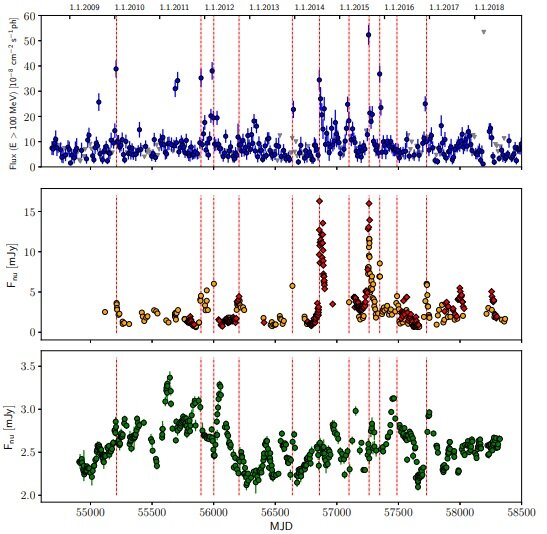#Gamma-ray and optical flares detected from the blazar S5 1803+784

“#Gamma-ray and optical flares detected from the blazar S5 1803+784”

Using NASA’s Fermi spacecraft, astronomers have conducted a long-term monitoring campaign of a blazar known as S5 1803+784 and have identified several gamma-ray and optical flares from this source. The finding is detailed in a paper published February 19 on arXiv.org.
Blazars are very compact quasars associated with supermassive black holes at the centers of active, giant elliptical galaxies, and can exhibit variability on a wide range of timescales. They belong to a larger group of active galaxies that host active galactic nuclei (AGN), and their characteristic features are relativistic jets pointed almost exactly toward the Earth.
Based on their optical emission properties, astronomers divide blazars into two classes: flat-spectrum radio quasars (FSRQs) that feature prominent and broad optical emission lines, and BL Lacertae objects (BL Lacs), which do not. At a redshift of 0.683, S5 1803+784 is a radio-selected BL Lac object. It showcases large variations in the optical range and is well detected at gamma-ray energies.
The source has been monitored with Fermi’s Large Area Telescope (LAT) between August 2008 and December 2018. By analyzing this dataset, a team of astronomers led by Roberto Nesci of the Institute for Space Astrophysics and Planetology (INAF-IAPS) in Rome, Italy, aimed to investigate light curves of S5 1803+784, expecting to find correlations between the blazar’s low- and high-frequency components.
“The aim of this work is to look for correlations among different wavelengths useful for further theoretical studies. We analyzed all the data collected by Fermi LAT for this source, taking into account the presence of nearby sources, and we collected optical data from our own observations and public archive data to build the most complete optical and gamma-ray light curve possible,” the researchers explained.
Although the study did not detect definite periodicity in the optical and gamma-ray light curves of S5 1803+784, several gamma-ray flares with optical coverage were identified. The researchers also detected two optical flares without a gamma-ray counterpart.
According to the paper, the optical spectral index of S5 1803+784 was constant during the monitoring campaign, regardless of the optical luminosity of the source. Moreover, the X-ray spectral index showed no evidence of hardening at higher fluxes.
The astronomers noted that the gamma-ray photon spectral index of the source showed no significant variations correlated with the luminosity. This is in contrast to the so-called “softer when brighter” or “harder when brighter” behaviors observed in some blazars.
“The absence of spectral evolution as a function of the luminosity could be related to the location of the gamma-ray emission region in the flaring state beyond the emission line region,” the researchers concluded.
Furthermore, the study found no correlation between X-ray and optical fluxes; however, the gamma-ray emission showed a fair correlation with the optical one, except in the case of some minor optical flares when no gamma-ray enhancements were identified.
Regarding the morphology of S5 1803+784, the radio maps show two new components originating from the blazar’s core and moving outward. This finding, according to the authors of the paper, suggests a causal connection between the mechanisms producing the high-energy and the radio-band radiation in blazars.
Research investigates variability of the blazar Mrk 421
Multi-wavelength flare observations of the blazar S5 1803+784, arXiv:2102.09779 [astro-ph.HE] arxiv.org/abs/2102.09779
© 2021 Science X Network
Citation:
Gamma-ray and optical flares detected from the blazar S5 1803+784 (2021, March 1)
retrieved 1 March 2021
from https://phys.org/news/2021-03-gamma-ray-optical-flares-blazar-s5.html
This document is subject to copyright. Apart from any fair dealing for the purpose of private study or research, no
part may be reproduced without the written permission. The content is provided for information purposes only.
If you liked the article, do not forget to share it with your friends. Follow us on Google News too, click on the star and choose us from your favorites.
For forums sites go to Forum.BuradaBiliyorum.Com
If you want to read more Like this articles, you can visit our Science category.




